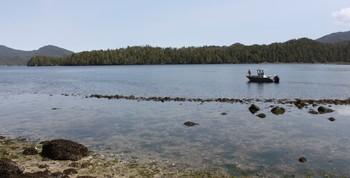Simon Fraser University
Source - http://www.sfu.ca/sfunews/stories/2014/ancient-clam-gardens-nurtured-food-security.html

Amy Groesbeck surveys clams in an ancient clam garden on Quadra Island.
A three-year study of ancient clam gardens in the Pacific Northwest reveals that coastal First Nations people used to reap superior harvests using rock-walled beach terraces.
The study’s lead author, Amy Groesbeck, was a student in SFU’s School of Resource and Environmental Management when she initiated the research for her master’s thesis. Her supervisors, who all helped with research and authoring the study, included SFU professors Anne Salomon, an ecologist; Dana Lepofsky, an archaeologist; and University of Washington biologist Kirsten Rowell.
In the past, as indigenous coastal communities from Alaska to Washington State grew in numbers, people needed to devise sustainable ways of feeding themselves. One of the ways they did this was by cultivating clams in human-made, rock-walled beach terraces known as clam gardens.
When the researchers transplanted more than 800 baby clams into six ancient clam gardens and five non-walled natural beaches to compare their growth rates they made a groundbreaking discovery.
They found that the ancient clam gardens produced quadruple the number of butter clams and twice the number of littleneck clams as the unmodified clam beaches.

A research boat surveys partially submerged ancient clam gardens in Kwakshua Channel, BC’s Central Coast
They also found that clams in the ancient gardens grew almost twice as fast and were more likely to survive than baby clams transplanted into unmodified beaches in the same area.
It is the first study to provide empirical evidence of ancient clam gardens’ superior productivity.
“We discovered that by flattening the slope of the beach ancient clam gardens expanded the real-estate for clams at the intertidal height at which they grow and survive best,” explains Salomon, an assistant professor in The School of Resource and Environmental Management.
“Traditional knowledge by coastal First Nations members further revealed that their ancestors boosted these gardens’ productivity by adding ground clam shell and pebbles to them.”
The researchers began their clam garden investigations in 2008. From 2009 to 2011 they focused their efforts on Quadra Island due to the sheer number of clam gardens available to survey and use as experimental replicates.
They surveyed 11 ancient clam gardens and 10 un-walled clam beaches and compared the number, size and weight of clams. They collaborated with indigenous knowledge holders from the Tla’amin First Nation and Laich-kwil-tach Treaty Society.
“Our discovery provides practical insights into sustainable ancient marine management techniques that can inform local food security strategies today,” says Groesbeck, who graduated in 2013. She is now a research assistant at the University of Washington.
According to the study, some of today’s shellfish aquaculture practices have been shown to undermine near-shore ecosystem resilience. They “alter the community composition of near-shore systems, change sediment characteristics, and facilitate the introduction of invasive species.”
Lepofsky says, “On the Northwest Coast we are fortunate to have both the tangible record of clam gardens and the culture-based knowledge of local indigenous people to educate us. The lessons learned here have global implications for food security, and about the way indigenous people interact with their land and seascapes.”
Lepofsky is now leading an archaeological team that is comparing the growth rate of clams prior to and during the time when ancient clam gardens were prevalent. The team has expanded its research to the province’s central coast and elsewhere via the Clam Garden Network, a newly formed group involving Aboriginal people and Parks Canada researchers.
“One of the reasons this study is so compelling is that it combines First Nations knowledge with the tools of archaeology and ecology,” says Lepofsky.
“While archaeologists often work with First Nations, it is somewhat rare in ecology. The combination of these three sources of knowledge is very powerful.”
The study has been published in PLOS One.